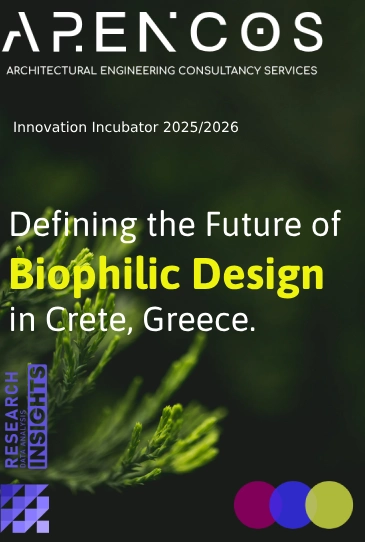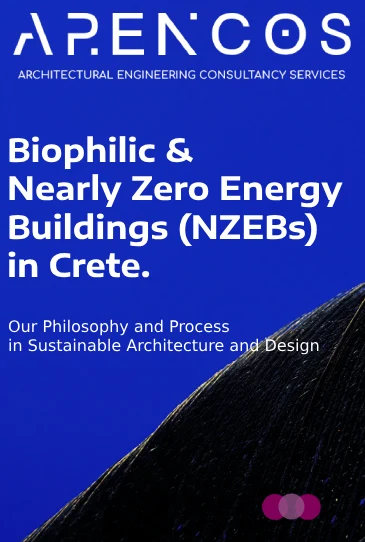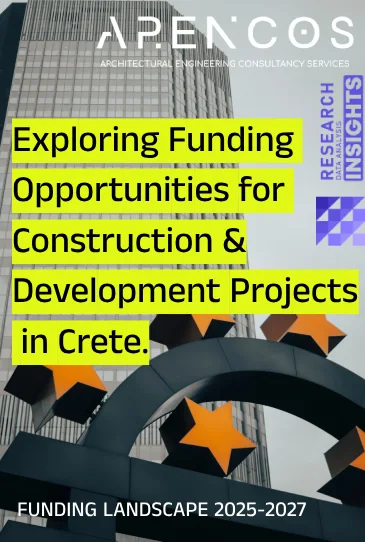Planning and Design a Sustainable House in Chania.
A Paradigm Project in Apokoronas.
Planning and Design a Sustainable House in Chania.
Site Selection and Orientation
By carefully and strategically selecting a site that offers natural advantages such as good drainage, extreme wind protection, and proximity to essential local amenities and services, the project minimizes ecological disruption, mitigates the effects of climate change, and promotes sustainable living.
Furthermore, the thoughtful orientation of the building, integrating state-of-the-art passive house principles, maximizes natural light and passive solar heating, reducing reliance on artificial lighting and heating systems, thus improving the building's energy performance.
Site Selection
The project site in Apokoronas, Chania was chosen with pragmatic, yet reliable sustainability and environmental considerations in mind. Key factors in this decision included:
Minimal Environmental Impact: The selected site requires minimal alteration to the natural landscape, preserving existing flora and fauna. This approach reduces soil erosion and protects local biodiversity. The plot contains an olive grove with 120 mature, yet highly productive trees.
Natural Drainage: The site benefits from good natural drainage, minimizing the need for artificial drainage systems. This reduces the risk of flooding and promotes the sustainable management of stormwater. By storing the water from the roof area on-site and then passing the recycled water via appliances to the building infrastructure rather than the storm drains, the system can lower peak flow rates and also help satisfy the owner’s demand for a “green” and “sustainable” house.
Proximity to Essential Services: The location is close to essential services such as pharmacies, shops, and public transportation. This proximity helps reduce transportation emissions by enabling residents to walk, cycle, or use public transit instead of relying on private vehicles.
Orientation
The orientation of the building is designed to optimize energy efficiency and enhance the living experience by:
1. Maximizing Natural Light: The building is oriented to take full advantage of natural light and the Mediterranean sun throughout the day, reducing the need for artificial lighting. Large windows and open spaces allow daylight to penetrate deep into the interior spaces.
2. South-Facing Windows: Strategically positioned south-facing windows capture more sunlight, providing passive solar heating during the cooler months. This natural heating reduces the need for conventional heating systems, lowering energy consumption and costs.
3. Seasonal Solar Control: Overhangs, shading devices, and carefully placed vegetation help control solar gain, preventing overheating during the summer while allowing maximum sunlight during the winter.
Planning and Design a Sustainable House in Chania.
Sustainable Materials Selection
- Recycled Steel: Utilized for the structural framework, recycled steel significantly reduces the need for new steel production, which is notoriously energy-intensive and contributes heavily to carbon emissions. By using recycled steel, the project not only conserves natural resources but also lessens the overall environmental impact associated with steel manufacturing.
2. Local Stone and Bamboo Flooring: Locally sourced stone from the wider area of Apokoronas, Chania is employed to minimize transportation emissions, support the local economy, and reduce the project's carbon footprint. The local stone is renowned for its durability and aesthetic appeal, making it an ideal sustainable building material.
Additionally, bamboo flooring is chosen as a sustainable alternative to traditional hardwood. Although bamboo is not native to Crete, Greece, it is imported sustainably and provides a rapidly renewable resource that grows much faster than hardwood, offering both environmental benefits and high durability.
3. Recycled Insulation: Insulation made from recycled materials such as denim or cellulose reuses waste products while providing effective thermal regulation. This not only enhances the energy efficiency of the building but also supports a circular economy by diverting waste from landfills and reducing environmental pollution. Locally sourced insulation materials further ensure that the project maintains a low carbon footprint.
| Material | Traditional Option | Sustainable Option | Cost per Unit (Traditional) | Cost per Unit (Sustainable) | Benefits |
|---|---|---|---|---|---|
| Framing | Conventional Steel | Recycled Steel | €100/m² | €120/m² | Reduces waste, lower carbon footprint |
| Flooring | Hardwood | Local Stone/Bamboo | €50/m² | €70/m² | Renewable, supports local economy |
| Insulation | Fiberglass | Recycled Denim | €15/m² | €20/m² | Reuses materials, non-toxic |
Total Architecture & Biophilic Design.
We have developed our sustainable residential construction approach, from over 25 years of experience, starting from a focus on Biophilic Design and Total Architecture to the more holistic approach we take today. Passive House design principles and considerations are now an integral part of our decision-making.


Author: Stavros Thomas
Developer strength and income resilience will be the focus as the recession hits the demand.
Sustainable Living in Chania, Crete
Most Wanted GreenParameters in People’s Houses Today.
Responders ranked the following features either “essential” or desirable”:
- “Energy Star-rated windows (92%)”
- “Energy Star-rated appliances (90%)”
- “Solar water heating/electric system (90%)”
- “Energy Star rating for the entire home (88%)”
- “Efficient lighting (vs. traditional light bulbs) (85%)”
- “Triple-pane insulated glass windows (78%)”
- “Insulation higher than required by code (77%)”
- “Water-conserving toilets (61%)”
- “Low-e insulating glass windows (61%)”
- “Tankless water heaters (60%)”
Planning and Design a Sustainable House in Chania.
Energy Efficiency
Solar Panels
Solar panels are strategically installed to optimize energy capture, significantly reducing reliance on non-renewable energy sources. In Chania's sunny climate, these panels can provide a substantial portion of the home's electricity needs, taking full advantage of the abundant sunlight.
The positioning of the panels ensures maximum exposure to sunlight throughout the year, enhancing energy production and contributing to lower utility costs.
Energy Storage
Incorporating advanced battery storage systems ensures that solar energy can be utilized even during non-sunny periods, such as nighttime or cloudy days.
These batteries store excess energy generated during peak sunlight hours, providing a reliable and continuous power supply. This approach not only maximizes the efficiency of the solar panels but also increases the home's energy independence and resilience, reducing dependency on the grid and ensuring a steady, renewable energy source regardless of weather conditions.
Table 2: Cost and Savings of Solar Panel Installation
| Component | Cost (Initial) | Annual Savings | Payback Period | Savings Over 10 Years |
|---|---|---|---|---|
| Solar Panels | €10,000 | €1,200 | 8.3 years | €12,000 |
| Battery Storage | €5,000 | €400 | 12.5 years | €4,000 |
| Total | €15,000 | €1,600 | 9.4 years | €16,000 |
Table 3: Cost and Benefits of High-Efficiency Windows
| Feature | Traditional Windows | High-Efficiency Windows | Cost (Traditional) | Cost (High-Efficiency) | Annual Savings |
|---|---|---|---|---|---|
| Windows (per m²) | Single-Glazed | Triple-Glazed | €100 | €150 | €300 |
| Total Cost (100 m²) | €10,000 | €15,000 |
Planning and Design a Sustainable House in Chania.
Water Conservation
Rainwater Harvesting
A sophisticated rainwater harvesting system is implemented to collect and store rainwater, effectively reducing the demand for municipal water supplies. This harvested rainwater is used for irrigation and other non-potable applications such as flushing toilets, washing clothes, and cleaning purposes.
By capturing and utilizing rainwater, the system not only conserves precious potable water resources but also lowers water bills and mitigates the impact on local water infrastructure. The storage tanks are designed to blend seamlessly with the landscape, ensuring both functionality and aesthetic appeal.
Low-Flow Fixtures
The installation of low-flow fixtures, including toilets, faucets, and showerheads, significantly reduces water consumption without compromising performance or user experience.
These fixtures are designed to deliver optimal water pressure and flow, ensuring comfort and efficiency. Low-flow toilets use advanced flushing mechanisms that require less water per flush, while low-flow faucets and showerheads incorporate aerators and flow restrictors to maintain a satisfying water flow.
Table 4: Cost and Savings of Water Conservation Features
| Feature | Cost (Initial) | Annual Savings | Payback Period | Savings Over 10 Years |
|---|---|---|---|---|
| Rainwater Harvesting | €2,500 | €200 | 12.5 years | €2,000 |
| Low-Flow Fixtures | €1,000 | €150 | 6.7 years | €1,500 |
| Total | €3,500 | €350 | 10 years | €3,500 |
Eco House Pricing Crete
Passive House vs. Standard House Cost Comparison
Suppose you are building an eco-house in Crete, Greece, by implementing and integrating eco-friendly materials, energy-efficient systems and appliances, and natural ventilation systems that reduce the need for artificial heating and cooling and ensure thermal comfort.
In that case, you can establish a space that is conducive to physical and mental well-being and ecologically resilient.
Here, we examine a 186.000 square meters new home built in Apokoronas, Chania in 2024. Compare building a Passive House, the highest energy efficiency standard for residential properties globally, with a regular house.
| ECO-HOUSE (€) | REGULAR HOUSE | |
| Building Cost | 330.000 | 300.000 |
| Heating Cost | 7.000 | 18.000 |
| Total Construction Cost | 337.000 | 318.000 |
| Annual Energy Bill | 450 | 1.880 |
Our analysis shows that eco-houses only cost about 6-8% more than traditional residential properties.
Similarly, according to our experience in Passive House Projects in Crete, a passive house typically costs 5-10% more than a typical residential house in Crete, Greece.
Is it Worthwhile?
In contrast with a “normal residential property“, the cost burden usually is considerably less for the construction of a certified eco-house, even if energy costs remain high in the future. Therefore eco-houses tend to be economically attractive and technically feasible – even though the cost benefits are not as enormously high as sometimes promised.

Understanding the Process
- Building a House in Crete: The Initial Steps
- Dealing with Construction Permits
- Choosing and Working with Builders
- Understanding the Design-Build Process
- Factors Affecting Construction Cost
- How Much Does it Cost to Build a House in Chania,
Latest Articles
Eco House Pricing in Crete, Greece.
How much does designing and building a sustainable house in Crete, Greece cost? What is a normal price range?
Designing and Building Houses in Crete with Local Materials: A Sustainable Approach.
This sustainable approach not only reduces the carbon footprint associated with transportation but also promotes self-sufficiency and preserves local traditions.
Tracking Interest and Demand for Eco-Residential Projects in Crete, Greece.
How are sustainable and eco-friendly homes impacting property values in Crete, Greece? What challenges do property owners face when transitioning to sustainable and eco-friendly homes?

ARENCOS
Sustainable Buildings in Crete
Let’s use the power of knowledge-sharing, critical thinking, and creativity to drive positive change towards a greener tomorrow in construction projects in Crete.
Inspired Spaces & Stories
Defining the Future of Biophilic Design in Crete
Biophilic Projects in Crete, Survey Biophilic Design in Residential Properties in Crete, Greece. Perhaps the most significant architectural design parameter today is the health and
Biophilic & Nearly Net-Zero Energy Buildings (NZEBs) in Crete: Our Philosophy
ARENCOS About this report At ARENCOS, we take our role seriously as one of Crete’s leading firms in sustainable architecture, biophilic design, passive house construction, and we
Chania Real Estate Investor Intentions Guide 2025
Key Insights & Market Outlook ARENCOS Chania Real Estate Investor Intentions Survey 2025. The ARENCOS Chania Real Estate Investor Intentions Survey 2025, conducted between Nove
Exploring Funding Opportunities for Construction & Development Projects in Crete.
Grants & Investment Opportunities Funding for Construction in Crete The European Union provides various funding programs and grants to stimulate economic growth and support sus
Architects in Crete: Designing Sustainable and Iconic Spaces
Architectural Design Services in Crete, Greece. We harness creativity, advanced technology and lessons learned, to create innovative, sustainable and future-proof properties for ou




